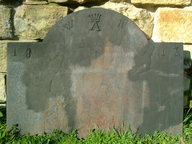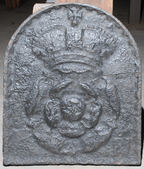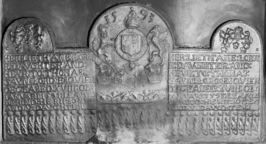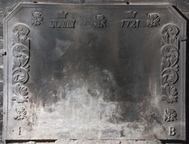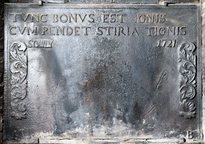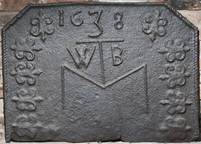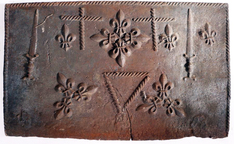-
14
Description: Arched rectangular shape; plain plate. Crowned capital ‘A’ between ‘W’ and ‘R’; divided date at top extremities of plate; single six-pointed star below ‘A’.
Notes: Earl’s coronet denotes the Earl of Ashburnham, furnace owner; ‘WR’ denotes William Rummins, furnace founder; 1813 - the furnace was blown out for the last time in late February 1813. Similar to, but narrower than the fireback at Church Farm, Penhurst (in private hands), and uses the same cipher and numbers. One of a small series of firebacks cast in the early-19th century for farms on the Ashburnham estate; this example was formerly at Great Sprays Farm, Penhurst.
Inscription: W A R / 18 * 13
- Decoration tags:
- rectangular with round arch (shape)
- none (edging)
- carved stamps
- individual letters
- individual numbers
- heraldic
- text
- objects
Manufactured: in 1813 at Ashburnham Furnace in the Weald area of England.
Current location: in private hands, Ashburnham, East Sussex, England.
- Attached to series:
- Ashburnham late series
- Date & initials firebacks
-
842
Description: Arched shape; cavetto-moulded edging invected on the inner edge; Tudor rose surmounted by a royal crown; monogram in bottom right corner.
Notes: The monogram, RN, is associated with the invected cavetto moulding; a recasting, replicating an earlier crack.
Inscription: RN
- Decoration tags:
- rounded arched (shape)
- scalloped cavetto (edging)
- whole carved pattern
- heraldic
- monogram
- royal
- text
Manufactured: in the early- to mid-17th century in England.
Current location: English Heritage Store, Atcham Business Park, Atcham, Shropshire, England.
Museum number: EH ASC 4490 (part of the English Heritage museum group)
- Attached to series:
- RN series
- Miscellaneous royal firebacks
-
200
Description: Composite; rectangular with semi-circular arches in middle (large) and ends (small) of top edge; rope on all edges except bottom; central panel effectively comprises an arched fireback form with Tudor royal arms (temp. Elizabeth I) with date above, and, below, letters G M, made from rope with fleur de lys terminals between two coronets surmounted by lions; below this are fronds with roses. On either side of this panel are placed the Anne Forster inscription panels; above each of these is a rose and crown with lion and dragon supporters, beneath which are three fleurs de lys. Along the base of the inscription panels and the central panel are single rows of ‘grape bunch’ shapes, beneath which are repeated trailing vine decoration from impressed wooden strips across the entire width of the fireback; 35 in all.
Notes: Formerly at Baynard's Park, Ewhurst, Surrey; GM probably refers to Sir George More, who built Baynards Park after buying the estate in 1587, and who moved to Loseley in 1604. The central coat of arms has been noted on two other firebacks, dated 1588 (no. 41) and 1595 (no. 482). The rose and crown stamps have been noted on a fireback in Haslemere Museum, and on examples illustrated by Lower (all of which bear the date 1582 and the initials IA; e.g. no. 107). The association of these stamps and the particular form of rope lettering, with the Anne Forster inscription and the ‘grape bunch’ shapes, both of which have been linked with other stamps from Pounsley furnace, suggests that they, too, were part of the stock of those works.
Inscription: 15 93 / GM / HER : LIETH : ANE : FORST/ R : DAVGHTER : AND : / HEYR : TO : THOMAS : / GAYNSFORD : ESQVIER / DECEASED : XVIII : OF: / IANVARI : 1591 : LEAVYNG / BEHIND : HER II : SONES : / AND : V : DAVGHTERS [twice]
Arms: Tudor royal
- Decoration tags:
- rectangular with three arches (shape)
- rope (edging)
- simple stamps
- carved stamps
- carved pattern panels
- individual letters
- individual numbers
- planklines
- heraldic
- armorial
- royal
- text
Manufactured: in 1593 possibly at Pounsley Furnace, Framfield in the Weald area of England.
Current location: not known.
Citation: Manning, O. & Bray, W., 1809, History of Surrey Vol. II (London, John White), p. 369n.
-
201
Description: Rectangular; moulded fillet edging on top and sides; TCI, also arranged symmetrically, in a widely spaced triad; below, symmetrical layout of central rose and crown between two concentric roundels, with two fleurs-de-lys outside.
Notes: The style of rose and crown is similar to that used in gun founding in the Tudor period, suggesting that the furnace that was the source of this fireback may have been used for that purpose. Formerly at Baynards Park, Cranleigh, Surrey.
Inscription: 16 T C I [triad] 70
- Decoration tags:
- rectangular (shape)
- complex, furniture-derived (edging)
- carved stamps
- individual letters
- individual numbers
- heraldic
- royal
- text
Manufactured: in 1670 in the Weald area of England.
Current location: not known.
- Attached to series:
- 1660s-90s Wealden series
- Date & initials firebacks
-
1056
Description: Canted rectangle; moulded fillet edging (top and sides); top line, 'daisy' plant stamp repeated three times, spaced evenly, with 'SOWLY' in a block, a ducal coronet above, between the left two, and '1721' in individual numerals, a ducal coronet above, between the right two; a swirling foliage stamp repeated down each side, a 'daisy' plant below each; initials 'I' and 'B' separately in bottom corners.
Notes: Sowley was the iron furnace in Hampshire owned in 1721 by the 2nd duke of Montagu, whose coronet is seen in the decoration, and operated by John White of Monmouth. The swirled foliage stamp is seen on other firebacks identified by the letters 'IB' between 1703 and 1721, probably indicating the same founder.
Inscription: SOWLY 1721 / I B
- Decoration tags:
- rectangular with canted top corners (shape)
- moulded fillet (edging)
- carved stamps
- individual numbers
- heraldic
- text
- plants
Manufactured: in 1721 at Sowley Furnace, Beaulieu in the New Forest area of England.
Current location: Palace House, Beaulieu, Hampshire, England.
- Attached to series:
- IB series
-
1057
Description: Rectangular; moulded fillet edging (top and sides); left justified text in upper case, in two lines: Tunc bonus est ignis cum pendet stiria tignis (Then fire is good when icicles hang from the eaves); below left, 'SOWLY' in a block; below right, '1721' in individual numerals; a swirling foliage stamp repeated down each side; initials 'I' and 'B' separately in bottom corners.
Notes: The source of the inscription is 'A Dictionarie in English and Latine for Children' by William Clark (London, Thomas Purfoot, 1602), p. 13. Sowley was the iron furnace in Hampshire owned in 1721 by the 2nd duke of Montagu and operated by John White of Monmouth. The swirled foliage stamp is seen on other firebacks identified by the letters 'IB' between 1703 and 1721, probably indicating the same founder.
Inscription: TUNC BONUS EST IGNIS / CUM PENDET STIRIA TIGNIS / SOWLY 1721 / I B
- Decoration tags:
- rectangular (shape)
- moulded fillet (edging)
- carved stamps
- individual numbers
- heraldic
- text
- plants
Manufactured: in 1721 at Sowley Furnace, Beaulieu in the New Forest area of England.
Current location: Palace House, Beaulieu, Hampshire, England.
- Attached to series:
- IB series
-
1058
Description: Rectangular; cavetto-moulded edging with an astragal inside; baroque-style shield of Montagu impaling Wriothesley.
Notes: Ralph Montagu (1638-1709), afterwards Earl of Montagu and later Duke, married Elizabeth Percy, née Wriothesley, daughter of the 4th Earl of Southampton, in 1673. She died in 1690; thus the fireback dates to between 1673 and 1690; Blazon: (Montagu) Argent, three lozenges conjoined in fess gules, a border sable; (Wriothesley) Azure, a cross or between four falcons close argent.
Arms: Montagu impaling Wriothesley
- Decoration tags:
- rectangular (shape)
- cavetto (edging)
- whole carved pattern
- heraldic
- armorial
Manufactured: in the late-17th century probably at Sowley Furnace, Beaulieu in England.
Current location: Palace House, Beaulieu, Hampshire, England.
- Attached to series:
- Personal armorial firebacks
- Wriothesley firebacks
-
1244
Description: Cavetto-canted arched rectangular shape with rectangular extension panels; cavetto-moulded edging, with astragal on wide fillet edging on the extension panels; central panel, crown, shield and Garter of the Tudor royal arms but with crowned lion and unicorn supporters, all within an undulating vine border; extension panels comprise a single letter (W on left, H on right) above an inward-facing seated squirrel.
Notes: The royal arms are a hybrid of the Tudor and Stuart achievement, quite crudely modelled. The initials and squirrels both relate to the Holte family who lived at Aston Hall, which was built between 1618 and 1623. The difference in the condition of the armorial and the extensions suggest that the armorial was significantly older than the extensions. The bottom 190mm of the fireback is concealed below, behind the grate placed in front of it.
Inscription: W / HONY SOIT QUI MAL Y PENSE / H
Arms: English Tudor royal with Stuart lion and unicorn supporters
- Decoration tags:
- rectangular with canted top corners and round arch (shape)
- cavetto (edging)
- carved stamps
- carved pattern panels
- extension panels
- heraldic
- armorial
- royal
- text
- animals
Manufactured: in the mid- to late-17th century in England.
Current location: Aston Hall, Aston, West Midlands, England.
(part of the Birmingham Museums Trust museum group)
- Attached to series:
- Stuart royal armorial firebacks
-
1242
Description: Canted rectangular shape; twisted rope edging (top and sides); top centre, date, 1638, with uneven figures (oversize 3), between two fleurs-de-lys; four fleurs-de-lys, lying horizontally, down each side; below date, slender 'T' shape above a slender 'M' shape, with initials 'W' and 'B' separated by the 'T' shape.
Notes: The distinctive fleur-de-lys has not been noted on any other fireback. Purchased by Birmingham Museums in 1982 at the sale of the contents of the house ‘Hildercroft’ on Highfield Road in Hall Green, Birmingham.
Inscription: 1638 / W T B / M
- Decoration tags:
- rectangular with canted top corners (shape)
- rope (edging)
- simple stamps
- carved stamps
- heraldic
- text
- objects
Manufactured: in 1638 in England.
Current location: Blakesley Hall, Blakesley Road, Yardley, West Midlands, England.
(part of the Birmingham Museums Trust museum group)
- Attached to series:
- Date & initials firebacks
-
1219
Description: Rectangular shape; twisted rope edging (top and sides); top centre, cross-shaped arrangement of four fleurs-de-lys between to crosses formed of lengths of twisted rope with single fleurs outside and beyond each of them a dagger, point upwards; to the right, a single fleur; bottom centre, a triangle formed of three lengths of twisted rope, vertex to the bottom, between two non-identical groups of three fleurs arranged in star pattern.
Notes: The style of the fleurs-de-lys associates this fireback with a series with several examples. The dagger type (approximate length 32cm) is different to others in the same series. Bishop & Miller Auctioneers, Stowmarket, 27 Jan 2022, lot 88 (£110).
- Decoration tags:
- rectangular (shape)
- rope (edging)
- simple stamps
- carved stamps
- heraldic
- apotropaic
- objects
Manufactured: in the mid- to late-16th century in the Weald area of England.
Current location: not known.
- Attached to series:
- Royal series
- Knife & Dagger stamp firebacks
